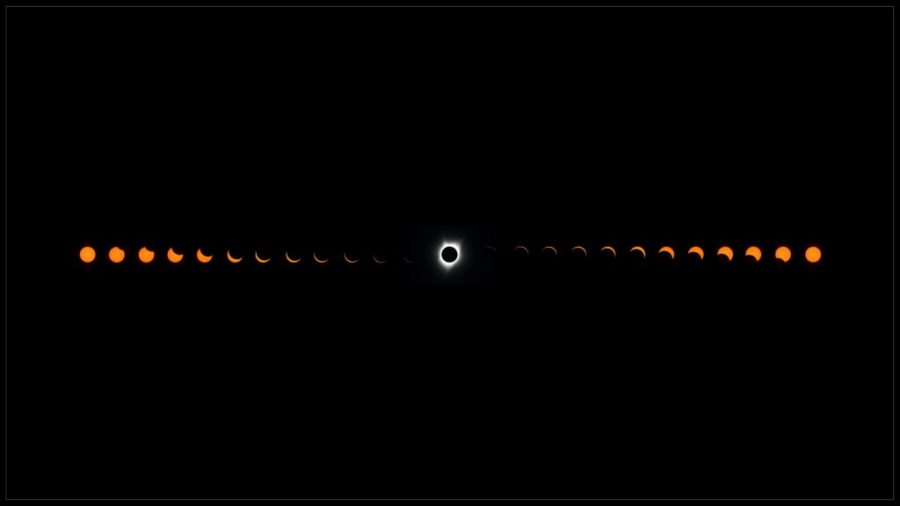As has become common knowledge by now, a total solar eclipse is when the moon passes in between Earth and the Sun, casting a shadow upon the Earth and momentarily blocking the Sun. Due to the elliptical orbit of the moon, total solar eclipses occur once every 18 months, or about two times every three years. Prior to the August eclipse, the last eclipse to take place close to Utah was on Monday Feb. 26, 1979 — 38 years ago. This meant that the August eclipse, at least for us Utahns, was a big deal.
We looked at different maps of Wyoming as we planned our trip to view the full eclipse. We decided to venture up to Lake of the Woods on the Wind River Mountain Range in Wyoming, a remote destination approximately 40 miles due east of Jackson. We traveled north with a group of nine on a Sunday afternoon in preparation for the total solar eclipse the following day, Monday, Aug. 21. This was going to be the first total solar eclipse any of us had ever seen before, so we had no expectations, predictions, or emotions for what was coming our way. During our drive up, the excitement kept building as we saw more and more people from all over the United States traveling to witness totality.
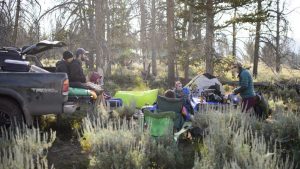
(Photo by Kiffer Creveling)
Building Excitement
As the sun set that first night, the air turned colder and colder. The temperature dropped even more once the sky turned black and the stars appeared. We could hear other eclipse chasers enjoying themselves with music, laughs, and the company they came with. A group of us walked down to the water’s edge to see one of the other party’s telescopes they had set up earlier. When we approached the other group, we found out that they had traveled from Colorado to view the eclipse. They invited us to look through their telescope to view various features within the night sky. You could visualize meteors burning up in Earth’s atmosphere, and constellations were as clear as glass. The Milky Way Galaxy was visible because it was a new moon. Polaris, the North Star, was shining brilliantly in the constellation Ursa Minor. The best, by far, was being able to see Saturn — we could actually make out the individual rings orbiting the planet. There was so much excitement in the air it was difficult to sleep knowing what would happen in less than 12 hours. We all fell asleep at some point anyway, gazing at the heavens above.
The next morning, we made breakfast and began setting up our chairs and cameras to view the solar eclipse. We had a few of our group members continually checking the sun’s status using eclipse glasses to let us know when the moon was beginning to make its pass in front of the sun.
Then they yelled, “It’s happening!”
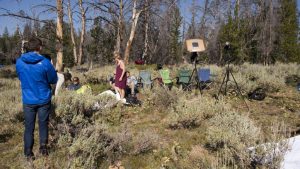
(Photo by Kiffer Creveling)
The Path of Totality
We all rushed to prepare for what we knew was coming next, quickly putting on our eclipse glasses. As parts of the sun began to disappear, the camping group next to us set off a few gun shots to notify everyone in the area. Suddenly, the intensity of the sun’s light began to decrease. The penumbra (partial shadow cast from the moon) was upon us. As the penumbra continued to pass overhead, and the moon was obscuring more and more of the sun, the thermometer we brought showed the temperature of the air was indeed dropping, just as our bodies told us it was. Every 10 minutes or so, we had one of our group members yell out the temperature.
The moon kept moving over the face of the sun, and more and more light was disappearing right before us. It got darker as we were nearing the umbra (the full shadow cast from the moon). The shadows became visibly sharper as the sun took on a crescent moon shape. We looked at the shadows around us as they, too, took the same crescent shape. We found ourselves struggling to believe our eyes at this amazing view.
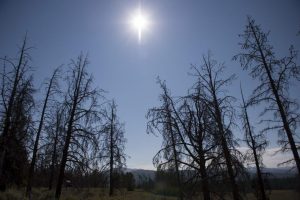
(Photo by Kiffer Creveling)
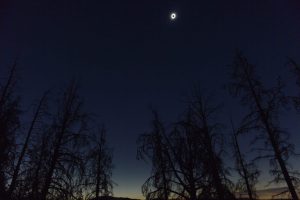
(Photo by Kiffer Creveling)
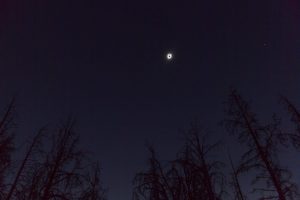
(Photo by Kiffer Creveling)
The moon’s course didn’t slow, and the sky and space around us continued to darken. For a few seconds, the Diamond Ring effect was visible, and then what are called Bailey’s Beads appeared as the light from the sun passed through the valleys of the moon’s surface. The umbra was overhead, and since we were in the path of totality, we were able to remove our glasses, looking with our naked eye at the eclipsed sun.
We cheered during this moment of complete totality. The corona, or the outer surface of the sun’s atmosphere, was the only light visible along with a small reddish layer that is the inner layer of the sun’s atmosphere, known as the chromosphere, shining intermittently around the perimeter of the moon.
Around us was a 360 degree sunset. The orange glow layered the horizon, transitioning from blue to a deep black near the sun. Stars became visible. The closest star visible to the naked eye was Regulus, which is seen in the night sky of the northern astronomical hemisphere during the winter time. Mercury, the closest planet to the Sun in our solar system, was visible along with Jupiter, Venus, and Mars. The eclipse created the darkest black we had ever seen. A small Cessna airplane flew right in front of our view, perfectly silhouetted by the corona.
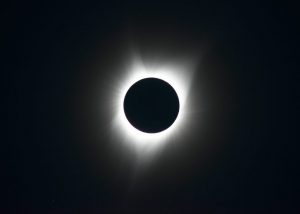
(Photo by Kiffer Creveling)
After exactly 2 minutes and 30 seconds of this miracle, sunlight began to peek over the moon through Bailey’s Beads, and then the diamond ring appeared vibrantly again before we were blinded by the light from the sun.
An Unforgettable Experience
From that point until the eclipse ended, our eclipse glasses never again left our faces. Just like that, totality — where daytime transitioned to nighttime in the middle of the day — was over. Even so, the shadows on the ground remained extremely sharp, and crescent moon shapes lay underneath the trees.The only difference now from before totality was that the temperature was increasing.
This was an experience of a lifetime. We are already marking our calendars for the next astronomical spectacle that will occur in the United States in 2024, starting in Texas and moving towards Maine.


